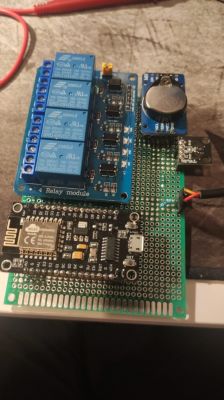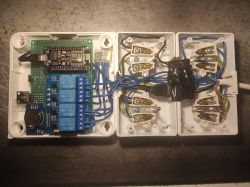FAQ
TL;DR: Add a 30 mA RCD—"30 mA RCDs must trip within 0.3 s at IΔn"—switch Live only, use IPX4 outlets, and add fuses; avoid upward‑facing sockets and plug‑in chargers inside boxes. [IEC 61008-1, 2023]
Why it matters: This FAQ is for DIY aquarium keepers building ESP8266/relay controllers on 230 V and shows how to reduce electrocution and fire risk.
Quick Facts
- Additional protection: use a 30 mA RCD/GFCI; typical trip ≤0.3 s at IΔn; test monthly. [IEC 61008-1, 2023]
- Always switch Live (L), not Neutral (N), to keep appliances de‑energized when off. [Elektroda, Anonymous, post #20709205]
- Avoid upward‑facing outlets; use splash‑resistant IPX4/IP44 accessories near aquariums. [Elektroda, TvWidget, post #20709285]
- Add a local fuse per channel; the thread flagged missing fusing as a hazard. [Elektroda, Ktoś_tam, post #20709388]
- Replace plug‑in USB chargers with enclosed, certified PSUs; secure strain relief and clearances. [Elektroda, Anonymous, post #20708461]
Should my relays cut the Live or Neutral on 230 V?
Always switch the Live conductor. Switching Neutral can leave equipment energized when “off.” That is dangerous around water. With Class 0 heaters or lamps, a fault could energize the aquarium. Rewire so Live passes through each relay COM/NO. Keep Neutral and Earth continuous. [Elektroda, Anonymous, post #20709205]
What shock protection should I add to an aquarium controller?
Use a 30 mA RCD/GFCI upstream. 30 mA devices must trip within 0.3 s at IΔn. At 5×IΔn, they trip within 40 ms. Bond all Class I devices to Protective Earth. Press the Test button monthly and after any changes. This reduces shock risk significantly. [IEC 61008-1, 2023]
What IP rating should outlets near an aquarium have?
Choose equipment rated at least IPX4 (IP44) where splashing occurs. IPX4 indicates protection against water splashes from any direction. Orient outlets sideways or down to limit ingress paths. Use covers or enclosures that maintain their IP rating when in use. Keep drip loops on all cords below outlets. [IEC 60529, 2013]
Do I need fuses inside the box if the circuit has a breaker?
Yes. Breakers protect building wiring, not your internal harnesses. Add a main fuse and per‑channel fuses sized to the cable and relay ratings. Place them where they are accessible. Label their values. The discussion flagged “no fuse” as a clear issue to fix. [Elektroda, Ktoś_tam, post #20709388]
Is a phone USB charger OK to power an ESP8266 in the enclosure?
Avoid plug‑in chargers crammed inside boxes. They can vibrate loose and lack strain relief. Use an enclosed, certified power supply mounted securely. DIN‑rail Class II PSUs (e.g., Mean Well HDR) fit enclosures. Keep low‑voltage wiring away from mains parts. [Elektroda, Ktoś_tam, post #20709388]
Can I keep WAGO connectors next to the Wi‑Fi antenna?
Separate the antenna from mains connectors and wiring. Keep the antenna clear of metal and high‑voltage conductors. This improves RF performance and maintains safe distances. Mount mains terminals away from RF modules and provide insulating barriers where needed. [Elektroda, Anonymous, post #20708461]
How do I rewire to switch Live with a relay board?
Follow this quick procedure:
- Identify Live, Neutral, and Earth using a tester and labels.
- Route Live into each relay COM; wire each outlet’s Live to the matching NO.
- Keep Neutral and Earth as unswitched busbars; do not break PE.
This keeps appliances de‑energized when “off.” [Elektroda, Anonymous, post #20709205]
Are generic relay modules safe for heaters and pumps?
Use relays rated for 250 VAC and your load current. Maintain required clearances and creepage inside the enclosure. Separate low‑voltage control from mains. Automatic control safety standards outline insulation, separation, and fault testing requirements for such builds. Choose certified parts when possible. [IEC 60730-1, 2020]
Will silicone sealing alone make my outlets waterproof?
No. Silicone around the faceplate does not seal the plug and socket interface. Water can still enter, especially when outlets face up. Use purpose‑built splash covers or relocate and reorient the outlets. Do not rely on sealant as your protection. [Elektroda, Ktoś_tam, post #20709388]
What about earthing and Class 0 devices near water?
Prefer Class I lamps or insulated stands around aquariums. Avoid Class 0 devices within reach. Connect all metal parts and Class I cases to Protective Earth via a reliable PE conductor. Use an RCD for additional protection. [Elektroda, Anonymous, post #20709254]
How should I separate low‑voltage ESP wiring from mains inside the box?
Provide physical separation, barriers, or adequate distances between 230 V and 3.3/5 V circuitry. Route low‑voltage on one side. Keep mains on the other. Use grommets and strain reliefs at entries. These practices align with control safety requirements. [IEC 60730-1, 2020]
How do I test that my RCD/GFCI still works?
Press the Test button to verify the device trips. Reset it after the test. Repeat monthly and after modifications. For a deeper check, use a plug‑in RCD tester that injects a small fault current. Replace devices that fail tests. [IEC 61008-1, 2023]
What does “safe” mean in practice for this project?
Design for foreseeable misuse, not just ideal operation. “A device should be safe in all foreseeable situations.” Imagine splashes, dropped tools, or a failed heater. Then add layers: RCD, fuses, proper earthing, and IP‑rated hardware. Write clear instructions and labels. [Elektroda, TvWidget, post #20708808]
Can I share Neutral across multiple relay‑controlled outlets?
Yes, keep Neutral as a continuous bus. Do not break Neutral or Earth with single‑pole relays. Bridge Lives at the relay board if you need common feeds, using proper copper links or terminal blocks. Verify color coding and labeling to avoid mix‑ups. [Elektroda, Anonymous, post #20708461]



 Link to project github
Link to project github



 Link to project github
Link to project github






